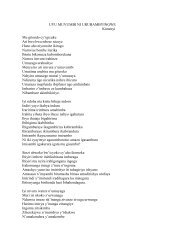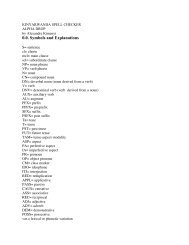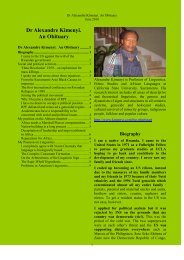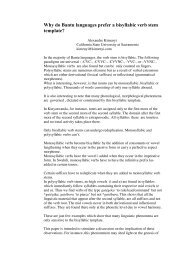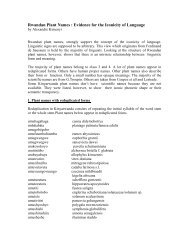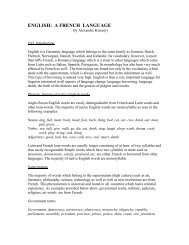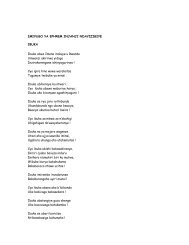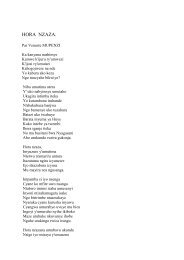KINYARWANDA TONES MADE EASY - Alexandre Kimenyi
KINYARWANDA TONES MADE EASY - Alexandre Kimenyi
KINYARWANDA TONES MADE EASY - Alexandre Kimenyi
Create successful ePaper yourself
Turn your PDF publications into a flip-book with our unique Google optimized e-Paper software.
<strong>KINYARWANDA</strong> <strong>TONES</strong> <strong>MADE</strong> <strong>EASY</strong>by <strong>Alexandre</strong> <strong>Kimenyi</strong>California State University at SacramentoKinyarwanda tones were thought to be the hardest, within the Bantu language group, to describe and explain.This is due to the fact that it indeed has a very complex verb structure. It is among the few which can havemultiple tenses within the same verb, mutliple object pronouns, multiple verb extensions and multiplegrammatical suffixes. Another factor which led tonologists to think that this language was complex wasbecause languages they have been dealing with have their tone rules apply from left to right and don’t haveextraprosodic domains whereas in Kinyarwanda, they apply from right to left and all vowels after the first moraof verb stem for lexical tones and the first mora of the second syllable for grammatical tones are extraprosodic.What is complex for verb tones is tone assignment. Language learners have to know which tense-aspectmodality(TAM) morphemes assign a tone on the first mora or the second syllable first mora of the verb stemand which ones erase tones. Noun tones are very simple. A simple noun can have only two tones and acompound-noun a maximum of three tones. This presentation is a summary of my 2002 book, A TonalGrammar of Kinyarwanda : An Autosegmental and Metrical AnalysisI. The nature of tone.In Bantu and African tonology, linguists have identified different types of tones : high tones, low tones, risingtones, falling tones, register tones, etc. This classification has unfortunately misled tonologists from finding outwhat the true nature of tone is and has led them to introduce unnecessary diatritics in the language descriptionand analysis. But they have also found similarities between tone, accent and stress. There are words whichhave tones and other which don’t. There is only one tone per morpheme. There are secondary or tertiary tones.Tones also delete. This phenomenon and behavior is shared by stress languages (<strong>Kimenyi</strong>, 2002). TheKinyarwanda data show that like in accent and stress languages tone and high tone are synonymous andredundant and that only one diatritic, the acute accent [´] is needed. Thus a word or morpheme has a tone ordoesn’t have one.II. The One tone ruleWhat is interesting about Kinyarwanda tones, is that a word has only one phonemic tone. Simple nouns canhave a secondary tone and compound nouns a tertiary tone all cerived from the underlying tone. Some nounshave stray tones which are not involved in tone rules. Verbs can have multiple phonetic tones caused by thephonemic tone spread rule in the metrical domain. Some tense-aspect-morphemes (TAM) which appear in theverbal pre-stem position have tones but these tones are also extraprosodic or stray since they don’t affect tonerules.III. Role of tonesKinyarwanda tones are either lexical, morphological or syantactic. Lexical tones differenciate words whichshare segmental features such as inda ‘stomach’ and indá ‘louse’ or umuryaango ‘family’ and umuryáango‘door’. Morphological tones correspond to segmental morphemes of other languages.Thus the verb gusoma /ku-som-a/ can appear without a tone, or with a tone on the last syllable or the firstsyllable in the present tense as in abaantu basoma ‘people read’, abaantu basomá ‘people who read’ or abaantubásoma ‘when people read’.Words can also lose or acquire tones depending on the position they occupy in the sentence structure.
For instance, the imperative verb form usually deletes tones. But when it is preceded by another word, it gets atone, even if it is lexically toneless.Geenda /ku-geend-a/ ‘go’vuga /ku-vúg-a/ ‘talk’Ubu géenda ‘now go’ubu vúga ‘now talk’IV. Prosodic Domain and Stray TonesExtraprosodic domains refer to the areas in the word structure where there is no tone assignment or toneactivity. In nouns, for instance, augments (preprefixes) and prefixes (class markers) don’t carry tones. Verbalextensions, both lexical extensions (derivational morphemes) and grammatical extensions (inflections) don’tcarry tone, either. In verbs, tones are assigned either on the first mora of the verb stem (lexical tones) or on thefirst mora of the second syllable. There is no tonal assignment or activity beyond that. Some prefixes such astense markers have tones, but these are referred to as stray tones because they are not involved in any toneactivity in the whole verb structure. It is the same with nouns as well. Some polysyllabic words have a tonewhich appears on some of the syllables but this tone is never involved in any tone activity such as tone addition,tone deletion, tone spread, etc. That is the reason why these tones are called stray tones.V. Floating TonesFloating tones are not attached to any particular mora or syllable. They are carried by few lexical items andmorphemes. For instance, some words such as the the copulars ni and si or the negator and presentative nta andnga when they are preceded by other words but don’t get any tone when they occur by themselves or in thesentence initial position. A word such as amáazi ‘water’ is underlyingly /a-ma-zi/, -zi being the stem, -ma- theclass marker and a- the preprefix or augment. For it to have a long vowel and a tone on the first mora of theclass marker, it is because of this floating tone of the noun stem –zi.VI. Tone RulesKinyarwanda has the following tone rules : secondary tone assignment or beat addition, tertiary toneassigmment, Meeussen rule or beat deletion, Iambic Reversal, Weak Beat Insertion, and tone assimilation andtone dissimilation.Secondary tone assignment or beat addition applies to nouns. If a noun has a tone on the third mora of the stemor beyond, the first mora of the stem acquires one as well as in igikóokó /i-ki-kookó/ ‘animal’. Verb stem withthe lexical tone, can many tones added if they have multiple object markers as in kunáhabíbamúkoreeshereza/ku-na-ha-bi-ba-mu-kór-iish-ir-iza/ ‘to also make them do it for him/her there’. The tertiary tone assignmentapplies with compound-nouns. The majority of compound-nouns in Kinyarwanda consist of a verb and a noun.The verb is on the left and the noun on the right as a complement. If it has a tone on this third mora or beyond, atone is assigned on this first mora and that of the verb as in umutégarúgoré /u-mu-teg-a#u-ru-goré/ ‘woman’.Meeussen rule deletes the tone on the right if two tones occur in adjacent moras. Since there is only one toneper morpheme, two tones appear in proximity because of tone rules namely beat addition and tone assimilation.For instance, the tone found in the second syllable of the name kiményi ‘<strong>Kimenyi</strong>’ deletes if it is preceded bythe associative morpheme na which puts a tone on the first mora of the following syllable if this one has a tone,as in na kímenyi /na kiményi/ ‘with <strong>Kimenyi</strong>’Iambic Reversal refers to rightward tone displacement found with few morphemes lacking a consonant in thefirst syllable as in úno /ú-no/ ‘this’ versus báno /bá-no/ ‘these’ where the tone remains in the first syllable inthe latter but moves to the second syllable in the former.Weak Beat Insertion is the addition of a toneless mora between two tone-bearing moras. This happens mostwith the monosyllabic associative morphemes na ‘with’, nka ‘like’ –a ‘of’ , the complementizers kó and thelocative clitics hó, mó and yó.nkíimbwá /nká+imbwá/ ‘like a dog’. But nkíngwe /nká+ingwe/ ‘like a leopard’
Tone assimilation and assimilation apply mostly nouns with onomastic prefixes.Tone assimilation is similar to the secondary tone assignment which occurs only if a noun has an augmentnyamúgabé /nya+u-mu-gabé/ ‘military general’. Tone dissimilation deletes the prefix tone if the head noun hasa tone : rwáamagana /rwáa+a-ma-gana/ ‘Rwamagana’ versus rwaamakúba /rwáa+a-ma-kúba/ ‘Rwamakuba’.It is important to not that in Kinyarwanda, the deletion of the augment bleeds the application of some tone ruleswhereas its presence or addition triggers them. It will be interesting to find if in other Bantu languages, theaugment also feeds and bleeds the application of tone rules also to see if languages which don’t have theaugment behave differently from those which do have them.



